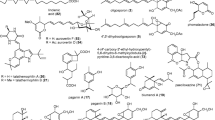Abstract
Two hundred and six bacterial isolates were obtained from leaf, flower and stem of three healthy plants,Euphorbia pulcherrima Willd,Pyrethrum cinerariifolium Trev. andHeracleum candicans Wall. The nematicidal activity experiment showed that a total of 92 isolates displayed activity againstCaenorhabditis elegans (Maupas) Dougherty, and 70 isolates resulted active againstBursaphelenchus xylophilus (Steiner & Buhrer) Nickle. Strain LCB-3 exhibited the strongest nematicidal activity against both two nematodes. According to the 16S rDNA, the strain LCB-3 was identified asBrevundimonas diminuta. Based on bioassay-guided fractionation, a nematicidal metabolite (R)-(−)-2-ethylhexan-1-ol was obtained from LCB-3. The median lethal concentrations (LC50) of the compound were 542.0 mg l−1 againstC. elegans and 168.1 mg l−1 againstB. xylophilus 48 h after treatment.
Similar content being viewed by others
References
Baczko K., Larpent C. (2000). Lipase-catalyzed transesterification of primary alcohols: resolution of 2-ethylhexan-1-ol and 2-ethylhex-5-en-1-ol. J. Chem. Soc, Perkin Trans., 2: 521–526.
Bongers T., Ferris H. (1999). Nematode community structure as a bioindicator in environmental monitoring. Trends Ecol. Evol., 14: 224–228.
Fernando W.G., Ramarathnam R., Krishnamoorthy A.S., Savchuk S.C. (2005). Identification and use of potential bacterial organic antifungal volatiles in biocontrol. Soil Biol. Biochem., 37: 955–964.
Gunatilaka A.A.L. (2006). Natural products from plant-associated microorganisms: distribution, structural diversity, bioactivity, and implications of their occurrence. J. Nat. Prod., 69: 509–526.
Klaus P. (2002). Current taxonomical overview of cultivated plants in the families Umbelliferae and Labiatae. Genet. Resour. Crop Evol., 49: 211–225.
Koenning S.R., Overstreet C., Noling J.W., Donald P.A., Becker J.O. (1999). Fortnum BA: Survey of crop losses in response to phytoparasitic nematodes in the United States for 1994. J. Nematol., 31: 587–618.
Köpcke B., Johansson, M., Sterner O., Anke H. (2002a). Biologically active secondary metabolites from the ascomycete A111-95. I. Production, isolation and biological activities J. Antibiot., 55: 36–40.
Köpcke B., Weber R.W.S., Anke H. (2002b). Galiellalactone and its biogenetic precursors as chemotaxonomic markers of the Sarcosomataceae (Ascomycota). Phytochemistry, 60: 709–714.
Kraouti N., Caujolle R., Labidalle S., Payard M., Loiseau P.M., Bories C., Gayral P. (1995). Synthesis and nematocidal activities of new analogs of pyrantel. Eur. J. Med. Chem., 30: 509–513.
Li G.H., Shen Y.M., Zhang K.Q. (2005). Nematicidal activity and chemical component of Poria cocos. J. Microbiol., 43: 17–20.
Li G.H., Zhang K.Q., Xu J.P., Dong J.Y., Liu Y.J. (2007a). Nematicidal substances from fungi. Recent Patents on Biotechnology, 1: 212–233.
Li Y., Chen X.G., Liu N., Liu C.S., Liu C.G., Meng X.H., Yu L.J., Kenendy K.F. (2007b). Physicochemical characterization and antibacterial property of chitosan acetates. Carbohyd. Polym., 67: 227–232.
Mbaria J.M., Maitho T.E., Mitemaand E.S., Muchiri D.J. (1998). Comparative efficacy of pyrethrum marc with albendazole against sheep gastrointestinal nematodes. Trop. Anim. Health. Pro., 30: 17–22.
Mochizuki M. (2003). Effectiveness and pesticide susceptibility of the pyrethroid-resistant predatory miteAmblyseius womersleyi in the integrated pest management of tea pests. Bio. Control., 48: 207–221.
Phongpaichit S., Rungjindamai N., Rukachaisirikul V., Sakayaroj J. (2006). Antimicrobial activity in cultures of endophytic fungi isolated fromGarcinia species. FEMS Immunol. Med. Microbiol., 48: 367–372.
Schwarz M., Kopcke B., Weber R.W.S., Sterner O., Anke H. (2004). 3-Hydroxypropionic acid as a nematicidal principle in endophytic fungi. Phytochemistry, 65: 2239–2245.
Silva R.M.D., Caugant D.A., Eribe E.R.K., Aas J.A., Lingaas P.S., Geiran O., Tronstad P.L., Olsen I. (2006). Bacterial diversity in aortic aneurysms determined by 16S ribosomal RNA gene analysis. J. Vasc. Surg., 44: 1055–1060.
Xu P., Li W.J., Xu L.H., Jiang C.L. (2003). A microwave-based method for genomic DNA extraction from Actinomycetes. J. Microbiol. (Chinese), 4: 73–75.
Yagi K., Williams N.Y., Cicerone R.J. (1993). Agricultural soil fumigation as a source of atmospheric methyl bromide. Proc. Natl. Acad. Sci. USA., 90: 8420–8423.
Author information
Authors and Affiliations
Corresponding author
Additional information
Co-authors: these authors contributed equally to this work.
Rights and permissions
About this article
Cite this article
Zheng, L., Li, G., Wang, X. et al. Nematicidal endophytic bacteria obtained from plants. Ann. Microbiol. 58, 569–572 (2008). https://doi.org/10.1007/BF03175559
Received:
Accepted:
Issue Date:
DOI: https://doi.org/10.1007/BF03175559




